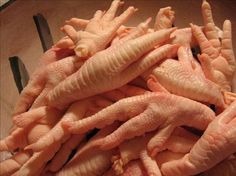Can Dogs Eat Chicken Feet?: Benefits, Nutrient Values, Risks
Can dogs eat chicken feet? Yes, dogs can eat chicken feet as they are a natural and nutritious treat for our canine companions. Chicken feet are rich in glucosamine, chondroitin, and collagen, which are beneficial for joint health and mobility, making them particularly valuable for older dogs or those with joint issues.
Additionally, chicken feet can help to clean your dog’s teeth and gums, promoting good oral health.
However, it’s important to feed chicken feet in moderation and to ensure they are cooked thoroughly to avoid any potential bacterial contamination.
Overall, chicken feet can be a healthy and enjoyable snack for your furry friend when given as part of a balanced diet.
Here’s a simple table outlining the nutrient value of chicken feet for dogs:
| Nutrient | Value |
| Protein | High |
| Fat | Low |
| Glucosamine | High |
| Chondroitin | High |
| Collagen | High |
| Calcium | Moderate |
| Phosphorus | Moderate |
| Calories | Low |
| Vitamin E | Moderate |
| Iron | Low |
| Magnesium | Low |
| Zinc | Low |
| Vitamin A | Low |
These values can vary depending on factors such as the size and age of the chicken, as well as the method of preparation. A veterinarian should always be consulted before making any major dietary modifications for your dog.

Benefits of Raw Chicken Feet for Dogs
Low in Fat
Raw chicken feet are low in fat, making them a healthy treat option for dogs. This can be beneficial for maintaining a balanced diet and preventing obesity in your furry companion.
High in Protein
Chicken feet are high in protein, which is essential for muscle development and overall health in dogs. The protein content in raw chicken feet can support your dog’s energy levels and promote muscle strength.
Rich in Glucosamine and Chondroitin
One of the key benefits of raw chicken feet is their high glucosamine and chondroitin content. These compounds are crucial for joint health and mobility in dogs, helping to support healthy bones and joints.
Joint Health Support
The glucosamine and chondroitin found in chicken feet can aid in maintaining good joint health in dogs.
These nutrients are particularly beneficial for older dogs or those with joint issues, as they can help improve mobility and reduce discomfort.
Low Calories
Raw chicken feet are low in calories, making them a suitable snack option for dogs that need to manage their weight. This can be advantageous for dogs on a weight management plan or those prone to weight gain.
Packed with Vitamins and Minerals
Chicken feet are rich in vitamins and minerals that are essential for your dog’s overall health. These nutrients can contribute to a well-rounded diet and support various bodily functions, promoting your dog’s well-being.
Incorporating raw chicken feet into your dog’s diet, when done safely and in moderation, can provide a range of nutritional benefits that contribute to their overall health and well-being.
what are the risks of feeding chicken feet to dogs
Feeding chicken feet to dogs can have potential risks despite their nutritional benefits. Here are some risks associated with feeding chicken feet to dogs:
Choking Hazard:
Chicken feet contain small bones and cartilage that can pose a choking hazard, especially for dogs that gulp their food without chewing properly.
Digestive Issues:
The tough texture of chicken feet can be difficult for some dogs to digest, leading to gastrointestinal problems such as blockages or constipation.
Bacterial Contamination:
Raw chicken feet can harbor harmful bacteria like Salmonella and E. coli, which can cause foodborne illnesses in dogs if not handled and prepared properly.
High Fat Content:
While low in fat compared to other parts of the chicken, chicken feet still contain fat that can contribute to obesity in dogs if fed excessively.
Allergic Reactions:
Some dogs may be allergic to chicken or poultry products, leading to allergic reactions such as itching, skin irritation, or digestive upset when consuming chicken feet.
Considering these risks, it’s important to exercise caution when feeding chicken feet to your dog. Always consult with your veterinarian before introducing new foods into your dog’s diet and ensure that the chicken feet are prepared safely to minimize potential health hazards.
How to Identify if my Dog has an Allergy from Chicken Feets
To identify if your dog has an allergy to chicken feet, you should observe for the following signs and symptoms:
Skin Irritation after eating chicken feet to dogs
Watch for any signs of itching, redness, rashes, or hives on your dog’s skin after consuming chicken feet.
Digestive Issues:
Monitor your dog for symptoms like vomiting, diarrhea, or gastrointestinal upset that may occur after eating chicken feet.
Behavioral Changes:
Look out for any changes in your dog’s behavior such as lethargy, restlessness, or agitation that could indicate an allergic reaction.
Respiratory Problems:
Keep an eye on your dog for symptoms like coughing, wheezing, or difficulty breathing after consuming chicken feet.
Ear Infections:
Allergies can sometimes manifest as ear infections in dogs, so check for any signs of ear irritation or discharge.
If you notice any of these symptoms after feeding your dog chicken feet, it’s essential to consult with your veterinarian promptly.
They can help diagnose the allergy and provide guidance on managing your dog’s diet to avoid allergic reactions in the future.
what age can puppy have chicken feets
Puppies can start having chicken feet once they are weaned off their mother’s milk and are eating solid food. This typically occurs around 6 to 8 weeks of age.
However, it’s essential to introduce chicken feet gradually and in moderation to avoid any digestive upset, especially in young puppies with sensitive stomachs. As always, consult with your veterinarian before introducing new foods to your puppy’s diet.
Frequently Asked Questions
The components of chicken feet include cartilage, skin, and tendons. These incredibly healthy chews may be a great treat for a variety of dogs of all shapes, sizes, and ages provided they are cooked correctly!
For a long time, chicken necks have been a common raw feeding diet staple. Their naturally occurring tendency to not splinter makes their bones an ideal means of supplying your dog’s raw food diet with the ideal ratio of calcium to phosphorus.
In general, dogs shouldn’t regularly consume raw chicken in their meals. Dogs may become poisoned by germs from undercooked meat, such as salmonella and campylobacter, and their digestive tracts may be harmed by any bones in the chicken.
It is safe for dogs to eat chicken feet. These healthy snacks are a terrific way to offer your dogs something to chew on while also providing them with vital nutrients.
Conclusion
In conclusion, Can dogs eat chicken feet? While chicken feet can be a nutritious and beneficial addition to your dog’s diet, they should be fed in moderation and prepared safely to avoid potential risks.
Always consult with your veterinarian before introducing new foods into your dog’s diet, and monitor your dog for any signs of allergic reactions or digestive issues.
With proper care and moderation, chicken feet can be a healthy and enjoyable treat for your furry friend.






